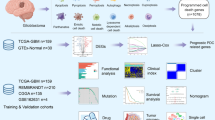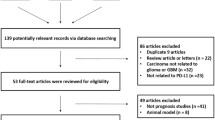Abstract
Purpose
Necroptosis is a necrotic-like cell death pathway in which Receptor-interacting serine/threonine-protein kinase 3 (RIPK3) plays a central role and may induce inflammation and immunity. Lower RIPK3 levels have been correlated with a poor prognosis in breast and colorectal cancer patients. Instead, in gliomas, the most prevalent among central nervous system cancers, necrosis concurs with a more aggressive and lethal outcome, suggesting that, in these cases, necrotic-like pathways may be linked to worse prognoses. Lower-grade gliomas (LGG) exhibit highly diverse clinical behaviors, ranging from slow-paced growth to fast progression to glioblastoma yet patient outcomes cannot be fully predicted through the available markers. To date, IDH mutational status is the most broadly used prognostic marker, albeit several candidates have been proposed to refine LGG subgrouping. Here, we aimed to assess RIPK3 role as a prognostic marker for LGG patients, independently of or in combination with IDH.
Methods
Using publicly available discovery (513 patients) and validation (134 patients) cohorts, we performed Kaplan Meier survival analysis and uni- and multivariate Cox regression models.
Results
RIPK3 is an independent prognostic marker in LGG patients, even when controlled by age and molecular or histological diagnostic criteria. Contrary to what was previously reported for other cancers, high RIPK3 expression levels correlates with an increased risk of death. Importantly, RIPK3 expression levels further split both the mutant and wild-type IDH patients into distinct risk groups.
Conclusion
RIPK3 expression levels can be used in combination with IDH mutational status to better subgroup LGG patients regarding overall survival.

Similar content being viewed by others
References
Ostrom QT, Gittleman H, Truitt G, Boscia A, Kruchko C, Barnholtz-Sloan JS (2018) CBTRUS statistical report: primary brain and other central nervous system tumors diagnosed in the United States in 2011–2015. Neuro Oncol. https://doi.org/10.1093/neuonc/noy131
Louis DN, Aldape K, Brat DJ, Capper D, Ellison DW, Hawkins C et al (2017) Announcing cIMPACT-NOW: the consortium to inform molecular and practical approaches to CNS tumor taxonomy. Acta Neuropathol. https://doi.org/10.1007/s00401-016-1646-x
Louis DN, Perry A, Reifenberger G, von Deimling A, Figarella-Branger D, Cavenee WK et al (2016) The 2016 World Health Organization classification of tumors of the central nervous system: a summary. Acta Neuropathol. https://doi.org/10.1007/s00401-016-1545-1
Network CGAR, Brat DJ, Verhaak RGW, Aldape KD, Yung WKA, Salama SR et al (2015) Comprehensive, integrative genomic analysis of diffuse lower-grade gliomas. N Engl J Med. https://doi.org/10.1056/NEJMoa1402121
Cairncross JG, Ueki K, Zlatescu MC, Lisle DK, Finkelstein DM, Hammond RR et al (1998) Specific genetic predictors of chemotherapeutic response and survival in patients with anaplastic oligodendrogliomas. J Natl Cancer Inst. https://doi.org/10.1093/jnci/90.19.1473
Bromberg JEC, van den Bent MJ (2009) Oligodendrogliomas: molecular biology and treatment. Oncologist. https://doi.org/10.1634/theoncologist.2008-0248
Cairncross G, Wang M, Shaw E, Jenkins R, Brachman D, Buckner J et al (2013) Phase III trial of chemoradiotherapy for anaplastic oligodendroglioma: long-term results of RTOG 9402. J Clin Oncol. https://doi.org/10.1200/JCO.2012.43.2674
Cairncross JG, Wang M, Jenkins RB, Shaw EG, Giannini C, Brachman DG et al (2014) Benefit from procarbazine, lomustine and vincristine in oligodendroglial tumors is associated with mutation of IDH. J Clin Oncol. https://doi.org/10.1200/JCO.2013.49.3726
Baumert BG, Hegi ME, van den Bent MJ, von Deimling A, Gorlia T, Hoang-Xuan K et al (2016) Temozolomide chemotherapy versus radiotherapy in high-risk low-grade glioma (EORTC 22033–26033): a randomised, open-label, phase 3 intergroup study. Lancet Oncol. https://doi.org/10.1016/S1470-2045(16)30313-8
Buckner JC, Shaw EG, Pugh SL, Chakravarti A, Gilbert MR, Barger GR et al (2016) Radiation plus procarbazine, CCNU, and vincristine in low-grade glioma. N Engl J Med. https://doi.org/10.1056/NEJMoa1500925
Noushmehr H, Weisenberger DJ, Diefes K, Phillips HS, Pujara K, Berman BP et al (2010) Identification of a CpG island methylator phenotype that defines a distinct subgroup of glioma. Cancer Cell. https://doi.org/10.1016/j.ccr.2010.03.017
Hanahan D, Weinberg RA (2000) The hallmarks of cancer. Cell 100:57–70. https://doi.org/10.1007/s00262-010-0968-0
Eom YH, Kim HS, Lee A, Song BJ, Chae BJ (2016) BCL2 as a subtype-specific prognostic marker for breast cancer. J Breast Cancer 19:252–260. https://doi.org/10.4048/jbc.2016.19.3.252
Vogler M, Butterworth M, Majid A, Walewska RJ, Sun X, Dyer MJS et al (2017) Concurrent up-regulation of BCL-X L and BCL2A1 induces approximately 1000-fold resistance to ABT-737 in chronic lymphocytic leukemia. Blood 113:4403–4414. https://doi.org/10.1182/blood-2008-08-173310.An
Kumar B, Cordell KG, D’Silva N, Prince ME, Adams ME, Fisher SG et al (2008) Expression of p53 and Bcl-xL as predictive markers for larynx preservation in advanced laryngeal cancer. Arch Otolaryngol—Head Neck Surg 134:363–369. https://doi.org/10.1001/archotol.134.4.363
Galluzzi L, Vitale I, Aaronson SA, Abrams JM, Adam D, Agostinis P et al (2018) Molecular mechanisms of cell death: recommendations of the Nomenclature Committee on Cell Death 2018. Cell Death Differ. https://doi.org/10.1038/s41418-017-0012-4
He L, Peng K, Liu Y, Xiong J, Zhu FF (2013) Low expression of mixed lineage kinase domain-like protein is associated with poor prognosis in ovarian cancer patients. Onco Targets Ther. https://doi.org/10.2147/OTT.S52805
Dixon SJ, Patel D, Welsch M, Skouta R, Lee E, Hayano M et al (2014) Pharmacological inhibition of cystine-glutamate exchange induces endoplasmic reticulum stress and ferroptosis. Elife. https://doi.org/10.7554/eLife.02523
Gao J, Qiu X, Xi G, Liu H, Zhang F, Lv T et al (2018) Downregulation of GSDMD attenuates tumor proliferation via the intrinsic mitochondrial apoptotic pathway and inhibition of EGFR/Akt signaling and predicts a good prognosis in non-small cell lung cancer. Oncol Rep. https://doi.org/10.3892/or.2018.6634
Geserick P, Wang J, Schilling R, Horn S, Harris Bertin PAJ et al (2015) Absence of RIPK3 predicts necroptosis resistance in malignant melanoma. Cell Death Dis 6:e1884. https://doi.org/10.1038/cddis.2015.240
Koo G-B, Morgan MJ, Lee D-G, Kim W-J, Yoon J-H, Koo JS et al (2015) Methylation-dependent loss of RIP3 expression in cancer represses programmed necrosis in response to chemotherapeutics. Cell Res 25:707–725. https://doi.org/10.1038/cr.2015.56
McDonald FE, Ironside JW, Gregor A, Wyatt BB, Stewart M, Rye R et al (2002) The prognostic influence of bcl-2 in malignant glioma. Br J Cancer. https://doi.org/10.1038/sj.bjc.6600217
Fels C, Schäfer C, Hüppe B, Bahn H, Heidecke V, Kramm CM et al (2000) Bcl-2 expression in higher-grade human glioma: a clinical and experimental study. J Neurooncol. https://doi.org/10.1023/A:1006484801654
Siegelin MD, Gaiser T, Siegelin Y (2009) The XIAP inhibitor Embelin enhances TRAIL-mediated apoptosis in malignant glioma cells by down-regulation of the short isoform of FLIP. Neurochem Int. https://doi.org/10.1016/j.neuint.2009.04.011
Zhou W, Yuan J (2014) Necroptosis in health and diseases. Semin Cell Dev Biol 35:14–23. https://doi.org/10.1016/j.semcdb.2014.07.013
Michelson N, Rincon-Torroella J, Quiñones-Hinojosa A, Greenfield JP (2016) Exploring the role of inflammation in the malignant transformation of low-grade gliomas. J Neuroimmunol 297:132–140. https://doi.org/10.1016/j.jneuroim.2016.05.019
Niederkorn JY (2006) See no evil, hear no evil, do no evil: the lessons of immune privilege. Nat Immunol. https://doi.org/10.1038/ni1328
Cerami E, Gao J, Dogrusoz U, Gross BE, Sumer SO, Aksoy BA et al (2012) The cBio cancer genomics portal: an open platform for exploring multidimensional cancer genomics data. Cancer Discov 2:401–404. https://doi.org/10.1158/2159-8290.CD-12-0095
Gao J, Aksoy BA, Dogrusoz U, Dresdner G, Gross B, Sumer SO et al (2013) Integrative analysis of complex cancer genomics and clinical profiles using the cBioPortal. Sci Signal. https://doi.org/10.1126/scisignal.2004088
Bao ZS, Chen HM, Yang MY, Zhang CB, Yu K, Ye WL et al (2014) RNA-seq of 272 gliomas revealed a novel, recurrent PTPRZ1-MET fusion transcript in secondary glioblastomas. Genome Res. https://doi.org/10.1101/gr.165126.113
Zhao Z, Meng F, Wang W, Wang Z, Zhang C, Jiang T (2017) Comprehensive RNA-seq transcriptomic profiling in the malignant progression of gliomas. Sci Data. https://doi.org/10.1038/sdata.2017.24
Lausen B, Biometry M (1992) Maximally selected rank statistics. Biometrics. https://doi.org/10.2307/2532740
Okamoto Y, Di Patre PL, Burkhard C, Horstmann S, Jourde B, Fahey M et al (2004) Population-based study on incidence, survival rates, and genetic alterations of low-grade diffuse astrocytomas and oligodendrogliomas. Acta Neuropathol. https://doi.org/10.1007/s00401-004-0861-z
Ceccarelli M, Barthel FP, Malta TM, Sabedot TS, Salama SR, Murray BA et al (2016) Molecular profiling reveals biologically discrete subsets and pathways of progression in diffuse glioma. Cell. https://doi.org/10.1016/j.cell.2015.12.028
Feng X, Song Q, Yu A, Tang H, Peng Z, Wang X (2015) Receptor-interacting protein kinase 3 is a predictor of survival and plays a tumor suppressive role in colorectal cancer. Neoplasma. https://doi.org/10.4149/neo_2015_071
Kim SK, Kim W-J, Yoon J-H, Ji J-H, Morgan MJ, Cho H et al (2015) Upregulated RIP3 expression potentiates MLKL phosphorylation-mediated programmed necrosis in toxic epidermal necrolysis. J Invest Dermatol 135:2021–2030. https://doi.org/10.1038/jid.2015.90
Barker CF, Billingham RE (1978) Immunologically privileged sites. Adv Immunol. https://doi.org/10.1016/S0065-2776(08)60930-X
Germano G, Allavena P, Mantovani A (2008) Cytokines as a key component of cancer-related inflammation. Cytokine 43:374–379. https://doi.org/10.1016/j.cyto.2008.07.014
Weller M, van den Bent M, Tonn JC, Stupp R, Preusser M, Cohen-Jonathan-Moyal E et al (2017) European Association for Neuro-Oncology (EANO) guideline on the diagnosis and treatment of adult astrocytic and oligodendroglial gliomas. Lancet Oncol. https://doi.org/10.1016/S1470-2045(17)30194-8
Cairncross G, Macdonald D, Ludwin S, Lee D, Cascino T, Buckner J et al (1994) Chemotherapy for anaplastic oligodendroglioma. National Cancer Institute of Canada Clinical Trials Group. J Clin Oncol. 1:11. https://doi.org/10.1200/JCO.1994.12.10.2013
Kristensen BW, Priesterbach-Ackley LP, Petersen JK, Wesseling P (2019) Molecular pathology of tumors of the central nervous system. Ann Oncol 30:1265–1278. https://doi.org/10.1093/annonc/mdz164
Priesterbach-Ackley LP, Wesseling P, Snijders TJ, De Vos FYFL, De Leng WWJ (2019) Molecular tools for the pathologic diagnosis of central nervous system tumors. Neuro-Oncol Pract. https://doi.org/10.1093/nop/npy041
Molenaar RJ, Maciejewski JP, Wilmink JW, Van Noorden CJF (2018) Wild-type and mutated IDH1/2 enzymes and therapy responses. Oncogene. https://doi.org/10.1038/s41388-017-0077-z
Molenaar RJ, Radivoyevitch T, Maciejewski JP, van Noorden CJF, Bleeker FE (2014) The driver and passenger effects of isocitrate dehydrogenase 1 and 2 mutations in oncogenesis and survival prolongation. Biochim Biophys Acta -Rev Cancer. https://doi.org/10.1016/j.bbcan.2014.05.004
Yang Z, Jiang B, Wang Y, Ni H, Zhang J, Xia J et al (2017) 2-HG inhibits necroptosis by stimulating DNMT1-dependent hypermethylation of the RIP3 promoter. Cell Rep. https://doi.org/10.1016/j.celrep.2017.05.012
Funding
This work was supported by Fundação de Amparo à Pesquisa do Estado de São Paulo (FAPESP) e Coordenação de Aperfeiçoamento de Pessoal de Nível Superior (CAPES) (Brazil) [Grant Nos. 2016/17628-0 and 2016/19110-0].
Author information
Authors and Affiliations
Corresponding author
Ethics declarations
Conflict of interest
The authors declare no potential conflicts of interest.
Additional information
Publisher's Note
Springer Nature remains neutral with regard to jurisdictional claims in published maps and institutional affiliations.
Electronic supplementary material
Below is the link to the electronic supplementary material.
Rights and permissions
About this article
Cite this article
Vergara, G.A., Eugenio, G.C., Malheiros, S.M.F. et al. RIPK3 is a novel prognostic marker for lower grade glioma and further enriches IDH mutational status subgrouping. J Neurooncol 147, 587–594 (2020). https://doi.org/10.1007/s11060-020-03473-0
Received:
Accepted:
Published:
Issue Date:
DOI: https://doi.org/10.1007/s11060-020-03473-0




